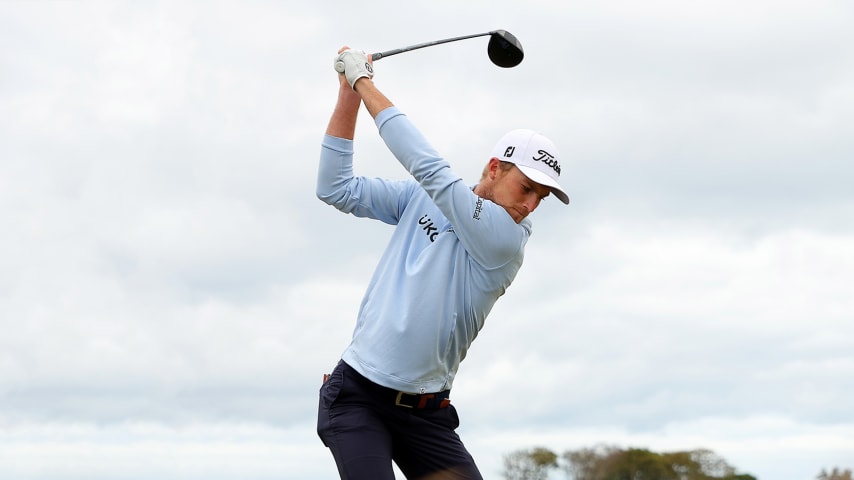Firm turf, lost clubs lead to changes for Webb Simpson
4 Min Read

Written by GolfWRX

Will Zalatoris’ new driver before Genesis Scottish Open
Just because PGA TOUR players are really good at golf doesn’t mean they’re immune to the pitfalls of air travel. At one point or another, every frequent flier experiences lost luggage, but a pro golfer losing his golf clubs en route to The Open Championship? That’s especially cruel.
Although Webb Simpson safely made the trek from the United States to the Edinburgh Airport in Scotland for the 150th Open Championship at St. Andrews, his golf clubs did not.
Yeah, that’s a problem.
PGA TOUR players work extremely hard with expert club builders and custom fitters to dial in the optimal set of golf equipment. When airline travel goes awry, it’s not as if they can just snag a rental set at the pro shop to replace their custom-made clubs.
Luckily, players do have access to numerous equipment trucks that are prepared to handle such ordeals.
When he arrived at St. Andrews, Simpson, a Titleist staffer, was able to get a backup set built to his previous specifications inside the Titleist truck. When it came to his wedges, however, Titleist Vokey wedge rep Aaron Dill changed things up for him.
While Simpson isn’t normally one to tinker with his wedges – or any of his clubs, for that matter – Dill had already been out on the course and saw first-hand the conditions, and the common changes that players were making to adjust.
“It’s really firm here,” Dill told Simpson on a phone call regarding the lost baggage. “This grass, it doesn’t work well with a lot of bounce. Do you trust me to make you some stuff that I think is going to be better?”
Simpson and his caddie Paul Tesori approved Dill’s request.
Typically, Simpson uses high-bounce Titleist Vokey wedges (52-12F, 56-14F and 60-06K) during events in the United States, where conditions aren’t as firm. Heading into the blazing fast, baked out Old Course setup, however, Dill wanted to put Simpson in lower-bounce offerings.
What is bounce, you ask? Click here for GolfWRX’s Gear 101, explaining in-depth what bounce is and why it’s helpful.
Upon Simpson’s arrival at The Open, Dill had three backup wedges ready, including a 52-08, a 56-08M, and a 60T.
“It was really more of a hunch,” Dill told GolfWRX.com on Wednesday. “I had already been on the course, I already know the conditions were (firm). …I just knew these would be better options for him.”
Based on GolfWRX’s Wednesday conversation with Dill, though, it may have been more than a hunch.
By Monday at 4 p.m., Dill says the Titleist truck ran out of Vokey T-grind wedges, which feature the lowest-bounce stock models in the Titleist tour offerings (4 degrees of measured bounce). The T grind, played by the likes of Jordan Spieth and Will Zalatoris, is already a popular option on the PGA TOUR. Pros gravitate toward the model due to the T’s aggressive heel and toe relief for increased short game control, and how the leading edge sits close to the turf on open-faced shots.
Showing the demand for low-bounce wedges, Dill estimates that he made 25-30 new Vokey T-grind wedges for players at The Open. Even some players who didn’t switch to the T grind specifically were reducing the bounce of their familiar wedge models, too.
Justin Thomas, for example, usually carries a wide-soled, low-bounce Vokey 60-06K grind. This week, Thomas is using a K-grind wedge with only 3 degrees of bounce. For comparison, most stock/retail wedges fall somewhere between 8 and 14 degrees of bounce, so 3 degrees is quite low. Patrick Cantlay also tested a low bounce T-grind lob wedge, and then after trying it out during a practice round, he requested even more bounce be polished off the sole.
Rory McIlroy also switched into a custom TaylorMade MG3 Raw LB (low bounce) 60-degree wedge with 7 degrees of bounce, whereas McIlroy previously played an MG2 HB12 (high bounce) lob wedge with 12 degrees of bounce.
“Most guys would tell you the fairways are running faster than the greens,” Dill told GolfWRX. “Trying to calculate that in these really firm conditions is tricky. A lot of guys have spent their time over the last 3 days figuring that out…you’re seeing guys reduce bounce for the square faced pitches, you’re seeing guys reduce bounce on the trailing edge to allow the ball to pop up easily, but finding the perfect combination that fits these bunkers is tricky.”
Ultimately, Simpson did get his original golf clubs and bag back from the airlines, and they’re safe in St Andrews. Looking at his setup on Wednesday prior to the event, Dill reports that Simpson was still using the custom low-bounce Vokey wedges he made for Simpson as backup options.
Dill may have said he “had a hunch” that Simpson would want lower bounce, but it was more of a well researched suggestion based on how many other Open Championship players were doing the same. It paid off for Simpson, who shot 71 in the opening round.


